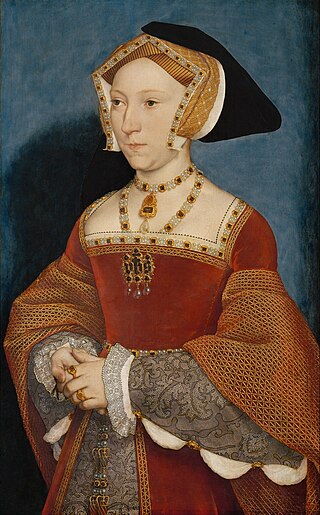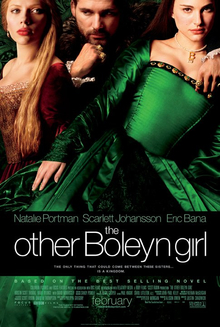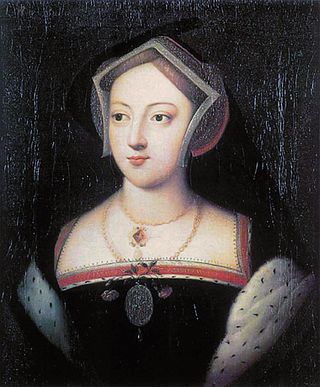
The House of Tudor was an English and Welsh dynasty that held the throne of England from 1485 to 1603. They descended from the Tudors of Penmynydd, a Welsh noble family, and Catherine of Valois. The Tudor monarchs ruled the Kingdom of England and the Lordship of Ireland for 118 years with five monarchs: Henry VII, Henry VIII, Edward VI, Mary I and Elizabeth I. The Tudors succeeded the House of Plantagenet as rulers of the Kingdom of England, and were succeeded by the Scottish House of Stuart. The first Tudor monarch, Henry VII, descended through his mother from the House of Beaufort, a legitimised branch of the English royal House of Lancaster, a cadet house of the Plantagenets. The Tudor family rose to power and started the Tudor period in the wake of the Wars of the Roses (1455–1487), which left the main House of Lancaster extinct in the male line.

Anne of the Thousand Days is a 1969 British historical drama film based on the life of Anne Boleyn, directed by Charles Jarrott and produced by Hal B. Wallis. The screenplay by Bridget Boland and John Hale is an adaptation of the 1948 play of the same name by Maxwell Anderson.

Jane Seymour was Queen of England as the third wife of King Henry VIII from their marriage on 30 May 1536 until her death the next year. She became queen following the execution of Henry's second wife, Anne Boleyn, who was accused by Henry of adultery after failing to produce a male heir. Jane, however, died of postnatal complications less than two weeks after the birth of her only child, the future King Edward VI. She was the only wife of Henry to receive a queen's funeral; and he was later buried alongside her remains in St George's Chapel, Windsor Castle.

Catherine Parr was Queen of England and Ireland as the last of the six wives of King Henry VIII from their marriage on 12 July 1543 until Henry's death on 28 January 1547. Catherine was the final queen consort of the House of Tudor, and outlived Henry by a year and eight months. With four husbands, she is the most-married English queen. She was the first woman to publish in print an original work under her own name in England in the English language.

Thomas Seymour, 1st Baron Seymour of Sudeley, KG, PC was a brother of Jane Seymour, the third wife of King Henry VIII. With his brother, Edward Seymour, 1st Duke of Somerset and Lord Protector of England, he vied for control of their nephew, the young King Edward VI. In 1547, Seymour married Catherine Parr, the widow of Henry VIII. During his marriage to Catherine, Seymour involved the future Queen Elizabeth I, who resided in his household, in flirtatious and possibly sexual behaviour.
Jane Boleyn, Viscountess Rochford was an English noblewoman. Her husband, George Boleyn, Viscount Rochford, was the brother of Anne Boleyn, the second wife of King Henry VIII, and a cousin to King Henry VIII's fifth wife Catherine Howard, making Jane a cousin-in-law. Jane had been a member of the household of Henry's first wife, Catherine of Aragon. It is possible that she played a role in the verdicts against, and subsequent executions of, her husband and Anne Boleyn. She was later a lady-in-waiting to Henry's third and fourth wives, and then to his fifth wife, Catherine Howard, with whom she was executed.

The Other Boleyn Girl (2001) is a historical novel written by British author Philippa Gregory, loosely based on the life of 16th-century aristocrat Mary Boleyn of whom little is known. Inspired by Mary's life story, Gregory depicts the annulment of one of the most significant royal marriages in English history and conveys the urgency of the need for a male heir to the throne. Much of the history is highly distorted in her account.

In common parlance, the wives of Henry VIII were the six Queens consort of King Henry VIII of England between 1509 and his death in 1547. In legal terms, Henry had only three wives, because three of his marriages were annulled by the Church of England. He was never granted an annulment by the Pope as he desired, for Catherine of Aragon, his first wife. Annulments declare that a true marriage never took place, unlike a divorce, in which a married couple end their union. Along with his six wives, Henry took several mistresses.

The Other Boleyn Girl is a 2008 historical romantic drama film directed by Justin Chadwick. The screenplay by Peter Morgan was adapted from Philippa Gregory’s 2001 novel of the same name. It is a fictionalised account of the lives of 16th-century English aristocrats Mary Boleyn, mistress of King Henry VIII, and her sister, Anne, who became the monarch's ill-fated second wife.

The Boleyn Inheritance is a novel by British author Philippa Gregory which was first published in 2006. It is a direct sequel to her previous novel The Other Boleyn Girl, and one of the additions to her six-part series on the Tudor royals. The novel is told through the first-person narratives of – Anne of Cleves, Katherine Howard, and Jane Boleyn, who was mentioned in The Other Boleyn Girl. It covers a period from 1539 until 1542 and chronicles the fourth and fifth marriages of King Henry VIII of England.

Henry VIII is a two-part British television serial produced principally by Granada Television for ITV from 12 to 19 October 2003. It chronicles the life of Henry VIII of England from the disintegration of his first marriage to an aging Spanish princess until his death following a stroke in 1547, by which time he had married for the sixth time. Additional production funding was provided by WGBH Boston, Powercorp and the Australian Broadcasting Corporation.

Henry VIII and His Six Wives is a 1972 British historical drama film directed by Waris Hussein, adapted from the 1970 miniseries, The Six Wives of Henry VIII. Keith Michell, who plays Henry VIII in the TV series, reprised his role. His six wives are portrayed by Frances Cuka, Charlotte Rampling, Jane Asher, Jenny Bos, Lynne Frederick, and Barbara Leigh-Hunt. Donald Pleasence portrays Thomas Cromwell and Bernard Hepton portrays Archbishop Thomas Cranmer, a role he had also played in the miniseries and briefly in its follow-up Elizabeth R.

The Sixth Wife is a 1953 historical novel by noted novelist Jean Plaidy. It recounts the tale of Catherine Parr, the sixth wife of Henry VIII, King of England. The novel covers the life of Catherine as Queen, and her fearful feeling of being replaced in the King's eyes.

Mary FitzRoy, Duchess of Richmond and Somerset, born Mary Howard, was a daughter-in-law of King Henry VIII of England, being the wife of his illegitimate son Henry FitzRoy, 1st Duke of Richmond and Somerset.

Doomed Queen Anne is a young-adult historical novel about Anne Boleyn by Carolyn Meyer. It is the third book in the Young Royals series. Other books are Mary, Bloody Mary, Beware, Princess Elizabeth and Patience, Princess Catherine. The book was originally published in the U.S. in 2002 by Harcourt/Gulliver Books.
Rex is a musical with music by Richard Rodgers, lyrics by Sheldon Harnick and libretto by Sherman Yellen, based on the life of King Henry VIII. The original production starred Nicol Williamson.
Alison Weir is a British author and public historian. She primarily writes about the history of English royal women and families, in the form of biographies that explore their historical setting. She has also written numerous works of historical fiction.

Mary I of England has been depicted in popular culture a number of times.

Mary Boleyn, also known as Lady Mary, was the sister of English queen consort Anne Boleyn, whose family enjoyed considerable influence during the reign of King Henry VIII.

The mistresses of Henry VIII included many notable women between 1509 and 1536. They have been the subject of biographies, novels and films.
















